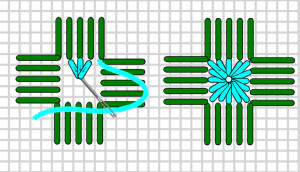When working an eyelet or cross stitch No fabric threads are snipped. No fabric thread or stitching thread is pierce.
Eyelets: Hardanger eyelet stitches are like a surface embroidery eyelet stitch in that they are a pulled stitch used to create an open area within the fabric. A Hardanger eyelet is often added within the border area to strengthen the edge of your worked design.
I prefer to complete eyelet work before any nearby cutwork as I feel when you lightly pull your stitching thread to open up the eyelet’s center that it stresses the fabric around it.
Start by securing the thread end within the backside of a nearby kloster block.
| Eyelet:
Ends of eyelet’s stitch can be worked within unshared fabric holes or sharing a fabric hole with a kloster stitch (chart to the left). I do the first two eyelet stitches with light tension but no pull. On the third stitch I start to apply a light pull as I come up for the fourth stitch. By midway stitches you should see that the center is opening up. To start, come up in a fabric hole shared with a kloster stitch. Go down into the center fabric hole of the eyelet. Working clockwise (or counter clockwise) come up at the neighboring fabric hole (thread tension is snug, not pulling). Work coming up along the outside (fabric hole shared with a kloster stitch), going down into the center fabric hole. You begin to open the eyelet (tension on the stitching thread) around the third eyelet stitch. When completed, I run a blunt ended needle through the eyelet’s hole to open them up to be about the same size hole. However I work the first one, clockwise or counter clockwise, I work them all going around clockwise or counter clockwise. |
| Cross Stitch:
End of a cross stitch can be within an unshared fabric holes (left chart) or sharing a fabric hole with a kloster stitch (right chart). Keep all of the cross stitches within a design slanted the same way, in that if the bottom leg of the cross stitch is slanted / then all of them are. This way the top leg of the cross stitch will be slanted \. As you work around a corner of the design you need to ensure that your bottom leg of the cross stitch carries on the correct slant. |



